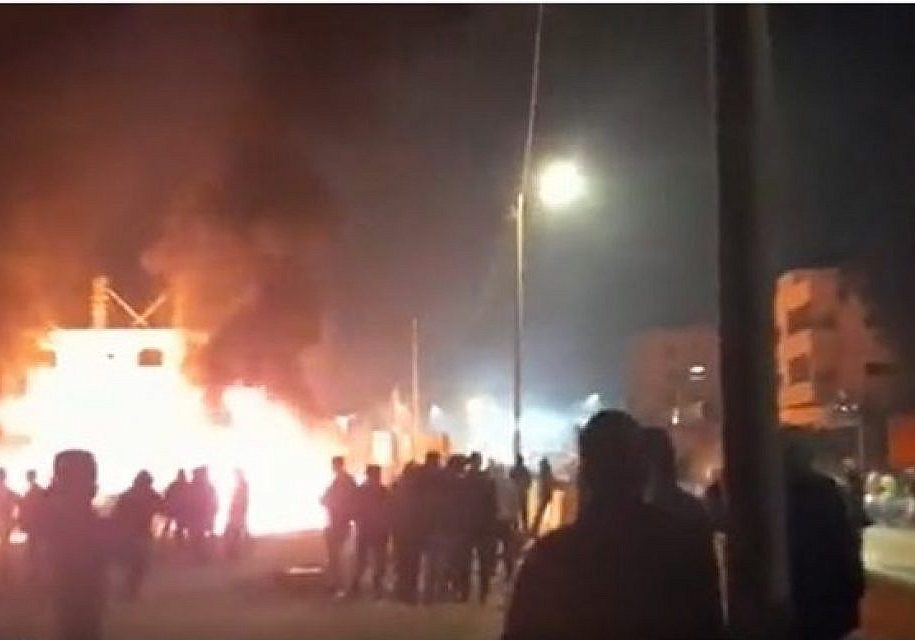FRESH AIR
In Gaza, taking no sides, but showing only one
July 11, 2019 | Ahron Shapiro
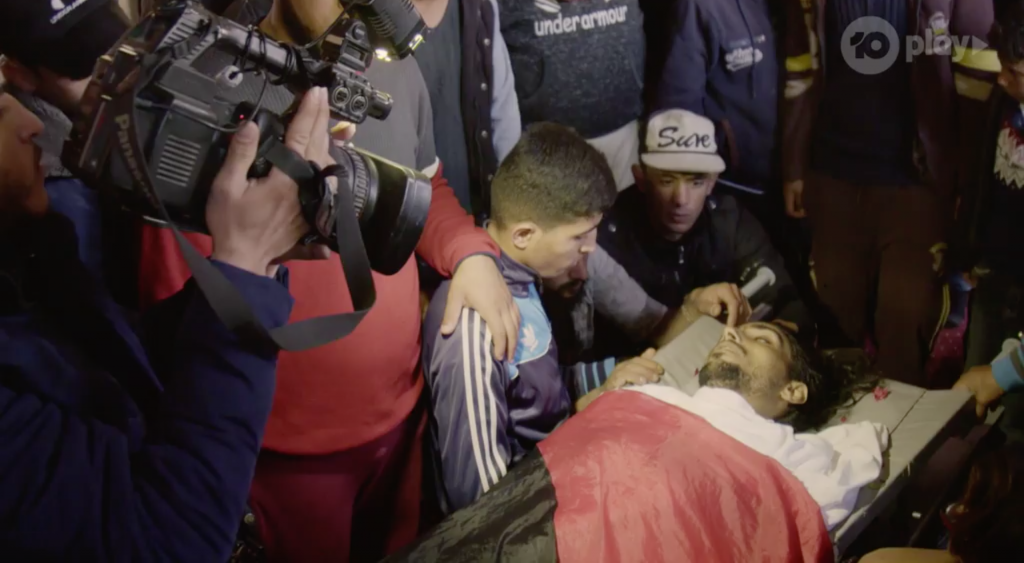
Todd Sampson’s Body Hack, whose third season premier was filmed in the Gaza Strip from the perspective of Palestinian protesters, aired on Channel 10 on June 25.
Sampson said his view of the conflict between Israel and Palestinians, as he narrated in his introduction, is that “both sides are right and wrong,” and indeed the episode as a whole cannot be described as entirely one-sided. Nevertheless, there were major lapses in the production at the expense of Israel.
- After raising viewer expectations that he would not “take sides”, Sampson failed to give the Israeli side any opportunity to rebut allegations against them made in the program.
- Sampson, who has no known expertise on the issues, himself spoke for the Israeli side, often portraying Israeli views poorly and inaccurately.
- Sampson appeared to overly rely on a Hamas-approved Gazan fixer. Comments made by Sampson suggest the fixer told Sampson that any reporting of his that Hamas wouldn’t like would put her at risk.
- “March of the Return”-themed border protests and a Palestinian “martyr” were portrayed as “peaceful”, ignoring and omitting all evidence to the contrary, including publicly available videos of armed infiltrations into Israel and the throwing of explosive devices over the border.
- Sampson failed to adequately define the scope of the blockade of Gaza, creating an exaggerated impression of it, while ignoring Egypt’s role in it entirely.
- No mention was made of Hamas’ use of incendiary and explosive kites at border protests or terror tunnels into Israel that have squandered hundreds of millions of dollars in international aid.
- Despite claiming not to take sides in the Israeli-Palestinian conflict, Sampson presented Israel’s use of tear gas to disperse Palestinian violent protests targeting the border fence as “cruel” and its use of non-lethal sniper fire aimed at the legs to prevent the most determined infiltrators from reaching and cutting the fence as lacking “restraint”. It is hard to see what Israel could do to contain the border attacks that Sampson would approve.
- Throughout, Sampson or his interviewees voiced a variety of claims against Israel that were either simply factually incorrect, or so lacking in context or fairness as to be grossly misleading.
The role of the fixer in Body Hack
Both in the episode and in promotional interviews, Sampson says he came to the Gaza Strip to make a show about emergency responders, but changed his mind once he arrived and surveyed the situation.
As Sampson told Channel Ten’s The Project on June 24:
Our plan [was to] go embed with first responders in Gaza. But once you’re there you can’t help but extend that focus on to all those, the two million people living under siege in Gaza.
While every video journalist who enters Gaza is required to use a fixer approved by Hamas, it is safe to say that the sudden decision to change the focus of the show left Sampson even more reliant on his fixer. It’s relevant, then, that Sampson told The Project that he “won’t mention her name for repercussions that may happen to her”.
Sampson said also told The Project, “you know I went to hug the fixer and she just – as I reached for her, in my culture you hug and she went and she just said, ‘Todd don’t hug me. Hamas is watching.’”
While not naming his fixer on The Projector elsewhere, he did mention she was “the first female fixer [in Gaza] ever”. The fixer, who is widely known by this title, is Ameera Ahmad Harouda. In a TED talk she gave in 2016, Harouda said:
“My job in Gaza is to arrange everything for journalists who come to my homeland to tell the stories about what’s going on in Gaza… if the journalist decides to cover a story the government doesn’t want us to cover, bad things could happen.”
From his comments on The Project, Sampson seems worried that even the relatively weak criticism of Hamas and defence of Israel made in the Body Hack episode would or could imperil that fixer.
To fully grasp why the program had so many deficiencies, it is essential to understand that Sampson was in the hands of a fixer who was determined to prevent him reporting anything Hamas would not like foreign audiences to know.
The show’s format
As a show produced for free-to-air television, Body Hack is divided into six segments separated by commercial breaks. Sampson gave each segment its own self-contained theme, sometimes with a sub-theme. For the purposes of clarity in this blog, I will categorise them as follows: 1 – Introduction and the “March of Return”; 2 – The martyr; 3 – Leg reconstruction featuring Doctors without Borders; 4 – Interview with Palestinian children and Islamic Jihad; 5 – Leg amputation featuring a local Gazan surgeon, and visiting dying baby; and 6 – Speedboats, beach protest and conclusion.
Speaking for Israelis
While Sampson says that he would not take sides between Israel and the Palestinians, he only films Palestinians, with the exception of a few seconds of file footage of the aftermath of Palestinian suicide bombings and other terror attacks on Israeli targets from the post-Oslo Accords era.
Instead of having Israelis speak in their own defence, Sampson assumes that role on their behalf, which is the extent of the show’s balance. In doing so, whether intentional or not, Sampson repeatedly creates Israeli “strawmen”- i.e. a misrepresented version of the Israeli viewpoint that is easier to rebut than the genuine argument.
At times during the episode, Sampson does defend Israel and criticises the Palestinian side or portrays it in an unflattering light. Yet with no known expertise about the Israeli-Palestinian conflict, it’s not surprising that his interpretations of the behaviour he witnesses in Gaza seems at times naïve, and his interpretations and explanations for Israeli behaviour are often wrong and generally inadequate.
More importantly, Sampson’s claim that went unchallenged, that “Israeli snipers [are] shooting peaceful protesters” (Segment 4) and his passing of damning judgement against Israel – expressed twice – that the IDF’s use of live fire at the Gaza border is explicitly without “restraint”, and implicitly excessive, unwarranted and disproportionate, sets the tone for the show.
With the exception of Segment 4’s nine-minutes (featuring interviews with Palestinian children and an Islamic Jihad terrorist) the 53-minute episode was constructed around this theme, which is neither objective nor factual.
In Segment 1, Sampson says that IDF snipers target Palestinian kids “mindlessly running towards them”. Viewers are left unaware of Israeli expert opinion that, far from acting mindlessly, Hamas encourages youth to move towards the fence to provide cover for its fighters.
Sampson says:
My overall impression was that these Palestinian kids were running mindlessly towards the Israelis, taunting them to fire. And the Israelis were coming to the party and firing. I can’t say that the Israelis were showing restraint. But I can say there was definite provocation. But not all provocations deserve bullets.
In Segment 3, Sampson says that Israeli soldiers target stone throwers at the border:
The Israeli military say lower limb shots are an act of restraint. Now I’m not certain what reasonable response is for people throwing rocks at the border fence. But I’m fairly certain it’s not this.
Sampson is entitled to share his own “impression” and opinions based upon what he sees, but if he is making judgement then he has an ethical obligation to allow the IDF an opportunity to explain their actions. Sampson fails to even attempt to do so.
Sampson’s personal defence of Palestinian protests
In his introduction and conclusion, Sampson glorifies and defends the violent protests at the border as an expression of hope.
In Segment 1, he says:
The protesters taunt the Israeli soldiers, and the soldiers return fire with interest. Israel argues that Hamas has co-opted the protests and are using its citizens as human shields for their politics.
And while that may be partly true, it ignores the deeper psychological motivation for resistance: Collective empowerment, also known as hope. Hope activates our parasympathetic nervous system and functions as a psychological barrier to despair. It can also reduce our fear response to danger and increase our ability to take risks.
In Segment 6, he says:
Many people in Israel are not proud of what’s happening in Gaza. They argue that if there were no terrorist attacks, there would be no blockade, and therefore, no protests. And while this may be true, it seems the blockade itself has now created its own form of terror. Hopelessness. I’ve come to believe these protesters don’t come here to die. They come here for the potential of a better life. And for them, that’s worth fighting for.
But does storming the fence, launching explosives and burning kites into Israel and building terror tunnels create hope and a “potential for a better life”? Or is it simply feeding another Palestinian “hope”, as voiced by Palestinian children interviewed by Sampson in Segment 4:
Sampson: Do you think you [Palestinians and Israelis] could share the land together?
Kids (subtitled): No.
Sampson: No? So what do you want to happen?
Kids (subtitled): We want to kill them, we want to liberate Jerusalem.
Kids (subtitled): If they become Muslims, we will allow them to live with us.
A vision echoed by the Palestinian Islamic Jihad terrorist interviewed by Sampson later in that segment:
Sampson: I absolutely believe Palestine has the right to exist and the right to exist peacefully. But I also believe Israel has the right to exist.
Masked terrorist (with subtitles): In fact, and the world should know this message. There is no peace as long as the Israeli enemy is here. The peace will begin when the so-called State of Israel ends.
The “hope” and “better life” both the adults and children speak about is predicated on a hope for eventual victory and the elimination of Israel.
No wonder Hamas continues to attack Israel instead of improving the quality of life of the Palestinians who live under its rule, or – heaven forbid – consider accepting the conditions of the Middle East Quartet that would pave the way to end the limited blockade, namely: Recognise the State of Israel, abide by previous diplomatic agreements, and renounce violence as a means of achieving goals.
After all, if Hamas were to act upon those things, Palestinians in Gaza would not have to hope for a better life, they would have one already. But for the Palestinians interviewed by Sampson, the only hope they can accept is one that envisions a future without Israel.
Minimisation of Palestinian threats
Sampson endorses the Palestinian narrative that the Gazan border protests are “peaceful”, by dismissing rock-throwing as a violent act altogether, but also ignoring significant video evidence of other violent acts at the protests.
Palestinians have thrown hundreds of explosive devices over the border during the protests
and carried out countless attempts at armed infiltrations, some of them successful.
However, Body Hack’s viewers are left entirely uninformed of these threats.
In fact, Sampson chooses to use the term “provocation” when describing Palestinian actions instead of “threats”. As stated above, in Segment 1 he explicitly considers “running towards the Israelis”, i.e. the border fence, a “provocation”. He returns to the term in Segment 6, saying it’s how Israelis view Palestinian tyre-burning.
Importantly, Sampson badly misrepresents the threat Israelis perceive by those who seek to breach the border fence. After initially accurately telling viewers early in Segment 1 that “anyone rushing the fence, or within 150 metres, are considered military threats [by the IDF] and are getting tear-gassed and shot at,” later in that segment he misrepresents that threat entirely.
Sampson says:
Israel has one of the most advanced militaries in the world. They’re clearly not afraid of kids throwing rocks. What is concerning is what they represent. What happens if 2,000,000 Palestinians leave Gaza and walk into Jerusalem. For them, this fear is real, and worth defending.
And again, in Segment 4,
Masked terrorist with subtitles: In fact, and the world should know this message. There is no peace as long as the Israeli enemy is here. The peace will begin when the so-called State of Israel ends.
Sampson: That is an incredibly bleak and hopeless message. And while it doesn’t justify Israeli snipers shooting peaceful protesters it does justify the real fear behind it.
Yet, again, these words are Sampson’s. Not the IDF’s nor any Israeli. In reality, there is indeed a fear guiding the IDF’s open-fire regulations at the border, but not what Sampson claims it is (fear of millions of Palestinians walking to Jerusalem, or fear stemming from Palestinian militants’ rejection of the existence of Israel).
Sampson could have asked an IDF commander to articulate that concern, which is exactly what the Israeli daily Yediot Ahronot did in May 2018, when the protests were at their height. While the weekly turnout at the protests are smaller today, they follow exactly the same template. (AIJAC translated the Hebrew article at the time and republished it in the Australia-Israel Review).
The IDF commander’s explanation is not brief, but deserves to be quoted here at length, due to the fact that Sampson’s harsh judgement of IDF actions colours the way the audience interprets the images of Palestinians they see over the entire episode – on the border, at a Palestinian funeral and in operating rooms.
Furthermore, it certainly fully contradicts Sampson’s claim that “Israeli snipers [are] shooting peaceful protesters”.
IDF company commander “Lahav” told Yediot Ahronot in May 2018:
Buses and pickups unloaded children and women. Trucks brought more tyres. More people and more people – masses. At its peak there was something like 15,000 here in front of us. They hurled rocks at us, Molotov cocktails, marbles, rocks propelled by various kinds of slingshots, and over loudspeakers they were calling “Itbach al ‘Yahud’ al-yisraeli (slaughter the Israeli Jew)” and they were calling on the masses to breach the fence and run to the Israeli villages and return the conquered lands.
People in the rear line were frenzied and pushed the crowds in front of them forward to the fence, pulling the people with their hands to move forward, cut the barbed wire outer fence and get past it. And the rolled barbed wire fence is even in Israeli territory. The fence with electronic monitors is a hundred metres into our area on purpose to allow the IDF room to respond. The other side knows that it is forbidden to enter these hundred metres. If they stand there on Hamas’ patrol road and do their protest, we wouldn’t fire anything, not even a cap gun. But the masses descend on the breaks in the rolled barbed wire fence that have already been cut [in previous attempts], and it’s nothing to make it from there to the last fence that can also be cut.
Look behind you, there are the homes of Kibbutz Nir Oz. A ten-minute run from here. If you cut the barbed wire, you can also cut the border fence. Of course, the whole area was covered with black tyre smoke. And the surge was spearheaded by women and children [as young as] 7-8. These children are small. They use them to light the tyres because they know we won’t shoot children and women. And under the cover of smoke the crowd tries to approach the border fence. The order is unequivocal, not to allow the crossing of the fence. No crossing whatsoever. But dozens of people storm the fence. In waves. Storming, retreating, and storming again. We are screaming in Arabic, “stop or I’ll shoot”, and if they don’t stop we fire tear gas. If it does not stop them, then we switch to sniper fire with the approval of a senior commander.
Factual errors
Segment 1 – Introduction and the “March of Return”
Claim: “Israel has blockaded the entire strip by land, sea and air. They control what comes in and out”.
Fact: The Gaza Strip has a border with Egypt at the Rafah Crossing that Israel has absolutely no control over, and therefore the Gaza Strip is affected by Egypt’s own independent decision to enforce that blockade.
Claim: “These [Gazan] kids have nothing to do. They have no space to play. They have no open areas. This is the biggest open area.”
Fact: Sampson’s claim is absurd to the point of leaving one dumbfounded. The Gaza Strip has soccer fields, an ever-growing number of playgrounds, even amusement parks, and swimming pools – yes, even water slides.
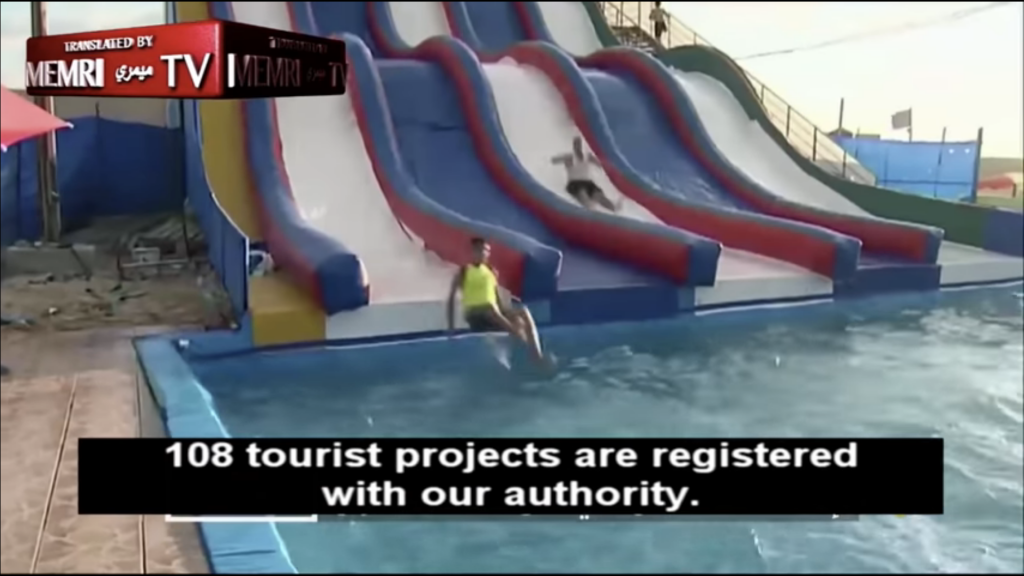
Sampson has said in numerous interviews that the footage from the border protest seen in Segment 1 was filmed within 30 minutes of him entering Gaza and getting picked up by his fixer. He had absolutely no first-hand basis for his bizarre claim that Gazan children have no space to play, and this comment lends more credence to the idea that Sampson was only repeating what his fixer had told him.
Segment 2 – The martyr
Sampson: If you could say something to the soldier about your son, what would you say?
Abed’s mother (subtitled): He was shot with a bullet, why? What did he do to them? He was there peacefully. Peaceful demonstrations.
Omission: Sampson failed to investigate the circumstances of Ehab Atallah Abed’s death. While Sampson showed pictures of Abed posing with his child smiling
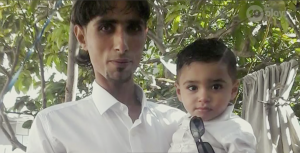
and in his wedding suit,
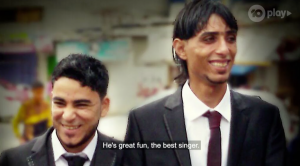
a simple search of YouTube revealed a video of Abed as a proud member of Fatah’s so-called “Rafah tyre unit”,
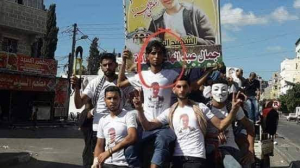
a quasi-military group trained to act in unison during the border protests to create tyre smokescreens, pull away barbed wire rolls protecting the fence (yes, that’s him in the picture)

and ultimately cutting and breaching the border fence with Israel for military objectives.
Segment 3 – Leg reconstruction featuring Doctors without Borders
Claim: “Generations of people have camped [in Gazan refugee camps] since being pushed back from their homeland by Israel, in what Palestinians still call the catastrophe of 1948.”
Reality: While in Segment 1, Sampson credited the Palestinians with their own narrative of how they became refugees: “The Palestinians believe they been forced from their ancestral homes by the creation of Israel in 1948”, here in Segment 3, he takes ownership of the Palestinian narrative of expulsion.
However, it is a fact that many Palestinians fled of their own volition or chose to become refugees rather than live in peace with the Jews as equal citizens in Israel.
As New York Times reporter Gene Currivan wrote on February 28, 1949 (Published March 1) reporting the Israeli capture of the Egyptian-held “Faluja Pocket” in the Lakhish region (emphasis added):
Israel added another piece of [Mandatory] Palestine to her occupied territory today and added another 1,000 persons to the Arab refugee problem when she officially took over control of the Faluja pocket, from which the Egyptian brigade was evacuated. The refugees had the choice of remaining as Israeli citizens or of leaving the pocket, and they took the latter course.
Claim: “In 2014, Israel went as far as sending troops and tanks into Gaza resulting in the deaths of over 2,000 people including 15 killed and 200 injured when this school was bombed.”
Fact: In citing the death toll from the 2014 war, Sampson does not differentiate between civilians and combatants. Furthermore, his description of the specific incident is deeply misleading. It involved a school compound in Beit Hanoun that was being used as temporary UN shelter for Palestinians displaced by the fighting. Furthermore, Sampson’s use of the term “bombing” implies deliberate aerial targeting, but according the an IDF investigation into the incident, in a battle with Hamas militants shooting from close to the compound, three mortar shells landed in the UN compound’s grounds due to human or technical error, inadvertently causing the casualties. The IDF’s report in Hebrew can be found here, and the AIJAC translation into English here.
Sampson also misstates the historic reason for Israel’s incursion into Gaza in 2014. It was Israel’s need to destroy Hamas’ terror tunnels, not the rockets, which led to the incursion.
Segment 4 – Interview with Palestinian children and Islamic Jihad
After Sampson interviews Palestinian children saying they would not play with Israeli children but would kill them if they had the chance, he makes the following claims:
Claim: “It’s easy to judge these kids but I’m not certain what we can expect from them, as all they have known is conflict and war.”
Fact: Sampson would like us to believe that wars with Israel have made the children this way, but ignores the fact that, in Gaza, even television programs made for preschoolers include incitement to kill Jews, and he misses an opportunity to test his hypothesis that conflict and war creates such views by failing to ask the same question of Israeli children on the other side of the border and compare the reactions.
Claim: “I’ve no doubt that some of them may end up working for Hamas. Others will be drawn to the more extreme Islamic Jihad.”
Fact: Palestinian Islamic Jihad (PIJ) is not notably more extreme than Hamas. In terms of their views on Israel’s right to exist, they are in perfect sync. Body Hack chooses to focus on Palestinian Islamic Jihad when everything Sampson says about it would apply equally to Hamas. Hamas masked militants look identical to the PIJ masked militants that Sampson interviewed, and it requires knowledge of their uniforms and insignias to tell the difference.
Claim: “Palestinian Islamic Jihad is a militant Islamic organisation with the sole aim of the destruction of Israel and the creation of a sovereign Palestinian state. Before the blockade, Islamic Jihad carried out dozens of attacks in Israel. Buses were a frequent target. So were restaurants, shopping malls and checkpoints. Hundreds of Israelis were killed and injured. Suicide bombers were a stock in trade of the jihadists. We’ve been asked to meet with Islamic Jihad at night. They are the second largest militant organisation in Gaza behind Hamas, the government.
Fact: While talking about PIJ’s history of terror attacks, one of the clips he uses is time-stamped from a terror attack perpetrated by Hamas in Jerusalem from September 4, 1997. This is unsurprising, because the fact of the matter is that, in the era of large-scale Palestinian terror attacks, from 1994 to 2005, Hamas (approximately 54 major attacks during the period) was responsible for more than twice as many terror attacks as PIJ (approximately 25). PIJ actually placed third in the number of successful terror attacks it was responsible for. Fatah was second (approximately 30).
In addition, Body Hack does not explain why Hamas, as the Government, allows PIJ to have a separate army and arsenal. Had it explored this issue, it would have discovered that Hamas and PIJ cooperate with one another and even issue joint media releases on occasion.
It’s an open question where Sampson got the idea PIJ was more extreme than Hamas and why he was set up with an interview with their masked militants and not Hamas. Moreover, the logical answer is that Hamas stands to benefit the most from the subterfuge of supposed moderation, and the one who would be in a position to advise Sampson on this matter would be his Hamas-approved fixer.
Claim: There are many in Israel who believe Iran has turned Islamic Jihad into its own military wing in Gaza.
Fact: Palestinian Islamic Jihad’s ties to Iran are not some Israeli theory but accepted as known fact by terror experts worldwide. Moreover, Hamas’ ties to Iran are also beyond dispute.
Segment 5 – Leg amputation featuring native Gazan surgeon, and visiting dying baby
Claim: “So, who is to blame for the lack of electricity and random power failures [in Gaza]? Well, the Palestinians blame the Israelis and there’s some truth to that. But it’s also true that the in-fighting between Hamas and Fatah in the West Bank plays a part. Israel claims they stop paying their bills.”
Fact: There really is no truth to the claim that Israel is to blame for the lack of electricity in Gaza. While Israel has, on rare occasion, temporarily suspended the transfer of fuel for the power plant as leverage to curtail Palestinian attacks, the lack of round-the-clock production at Gaza’s power plant has nothing to do with Israel, which is generally prepared to deliver whatever fuel for the plant Hamas purchases. Israel provides additional power to Gaza, and Gaza is expected to pay for that. If Gaza fails to pay for the additional electricity, it’s not Israel’s fault if power occasionally is cut off as a result.
Claim: Sampson: Israel’s blockade of Gaza “has resulted in fewer [medical] supplies getting in…this baby is going to die. Not from the infection, but lack of supplies.
“I understand it’s a conflict. I understand that there’s a narrative, but it’s fucking atrocious that this child is definitely going to die because of lack of supplies. I’m not pointing fingers. I’m not taking sides. I’m in a hospital with a small baby that is not going to live because she can’t get medical supplies. The things we take for granted.
“There is no doubt the Israeli blockade has resulted in fewer supplies getting in, but like everything else in Gaza it’s not that simple. In 2018, Hamas rejected a shipment of medical aid from Israel saying they would not accept medicine from the murderers of their people. There is an unfortunate military term for this innocent young child. Collateral damage.”
Fact: The truth is unequivocal: Israel’s limited blockade of Gaza affects specific military and dual use items and does not prevent Gazan doctors from importing medicine or the vast majority of medical equipment.
Claim: [Local Gazan surgeon Adnan Bursh]: “They [the IDF] are using bullets called butterfly bullets. It’s abnormal bullets. It explodes inside the body and destroys everything there. Even soft tissue, bones, anything there. So, we always find the entry is about just 1cm. The exit 20cm or more than 20cm. Always they are using this bullet, and they are always targeting the joints.”
Fact: The allegation that the IDF uses butterfly bullets is simply a Palestinian fiction. Even Avihai Stollar, an army researcher from the NGO Breaking the Silence – an organisation quite hostile to the IDF – says the IDF does not use “butterfly bullets” or even possess them.
Like snipers in other armies, the IDF does use a type of hollow-point sniper ammunition called “Open Tip Match” (OTM). But research has shown OTM bullets don’t cause worse injuries than ordinary bullets.
In a piece for the left-wing activist website +972, Stollar defended the IDF on this exact claim.
He wrote:
In practice, wounds caused by 7.62 millimeter OTM bullets do not differ from wounds from standard “Full Metal Jacket” (FMJ) bullets with a similar caliber, according to the U.S. Army’s findings….
So, if they are not “butterfly bullets” as the Gazan surgeon claimed, why, then, do Israeli sniper bullets sometimes cause the leg damage such as the kind we saw in Body Hack? The answer is simply force and speed – a necessary tradeoff for accuracy needed to avoid hitting vital organs and innocent bystanders.
As Stollar wrote:
The use of sniper rifles against closer targets increases accuracy and decreases the chances of wounding an unintended target, but it also leads to far more severe wounds due to the greater speed and force of the bullet.
Segment 6 – Speedboats, beach protest and conclusion
In this final segment, Sampson, in a speedboat, confuses the viewer and fails to accurately describe the situation he has placed himself.
“So, we are racing to the next protest. You feel incredibly exposed out here. Palestinians are not allowed to go beyond three to six nautical miles offshore.
Some 4,000 fishermen work in this restricted band of water. Ninety-five percent of them live under the poverty line.
They’re restricted. They can’t move, and it’s a big food source. This is a protest to say, free us. Let us do our job. Let us be able to bring food back.
If they get too close to the exclusion zone, the patrolling Israeli Navy pushes them back with gunfire.
Well, it looks like we’re not too far away now. It’s quite nerve-wracking knowing that drones are above us and the navy there and everyone is looking at us.
This protest is at the northern end of Gaza, and from here, it looks like a war zone.
See, this is the problem now. The burning of the tires. You can see the black smoke. The Israelis basically said, no tire burning. If you tire burn, they see it as provocation.
[Bullet ricochet sound]
Jesus! Whoa! Whoa! Whoa! Whoa! That is, like, sniper fire, man.”
[Unidentified English-speaking voice, off-camera]: Lets go in. Or turn around.
Sampson: “They’re ricocheting off the water. Jesus! Shit!”
[Unidentified English-speaking voice, off-camera] “Go in! Go in!”
Sampson: “The Israeli navy has opened fire on us, forcing us to the beach”
Problematic aspects: The segment is shot in a grossly misleading fashion. Sampson, standing in a speedboat at full throttle, opens the segment by mentioning that they are “racing to the next protest” in a speedboat. From this vantage point, he goes on to discuss the gripes of Gazan fishermen, who complain that Israel does not let them fish far enough out to sea to make a living and shoots at fishing boats that challenge the outer boundaries. At this point in time, his boat is actually speeding towards Israeli waters and Israel’s nearby public beach at Zikim (just 2km from the fenceless sea border, which he never makes clear) and predictably comes under warning shots. Given the option to turn back south towards Gaza City or go to shore at the border zone, they bring the boat to shore. However, despite being on or near the sand (the viewers don’t see where the boat is left), the speedboat remains too close to the border, which likely explains why warning shots continue after Sampson disembarks from the boat.
Claim: “See, this is the problem now. The burning of the tyres. You can see the black smoke. The Israelis basically said, no tyre burning. If you tyre burn, they see it as provocation.”
Fact: We do not hear these words spoken by any IDF spokesperson, and it’s very unlikely the IDF would use that terminology or consider the burning of tyres themselves as cause to shoot a weapon. Instead, any shots we see fired near the border would be necessitated by attempts by the protesters to get close enough to breach the fence, while the IDF would also be expecting fence-cutting attempts to take place under the cover of the smokescreen created by the burning tyres.
On documentaries, fairness and balance
On July 9, in response to criticism that he failed to give an accurate and substantive Israeli perspective to counter the Palestinian claims aired on his program. Sampson tweeted that “A documentary ABOUT THE PEOPLE GAZA [sic] doesn’t need to be balanced, it needs to be true to my experience.”
This blog recognises that, as a documentarian producing a piece to be aired on commercial television, Sampson was under no obligation to be balanced, or even fair. Indeed, when it comes to documentaries, no widely accepted standards exist, the way they do in news journalism.
As Christopher Lukas, then-chairman of the Communications, Film and Video Department of New York’s City College, wrote about documentaries in 1986:
There is nothing in the nature of the film documentary that demands it be a journalistic medium. Rather, it documents points of view about issues of importance; not as part of a news operation, but as the original and compelling vision of some individual.
Sampson’s arguments in defence of Israel on the program seem to be his attempt at some sort of fairness, not balance. The difference is stark.
In an essay “Fair vs. Balanced” published in July 2018 on the website of the International Documentary Association, two-time Academy Award-nominated documentary director and editor Marshall Curry wrote about one of his own documentaries:
I would often get comments about how “balanced” it was. But that word always made me wince. I didn’t intend the film to be balanced; I intended it to be fair.
Curry added:
The different voices included in [my documentary] aren’t there because I was seeking balance or I wanted to push aside my point of view. They were included because they reflected my point of view, which is not neatly resolved. Balance is mathematical: If you include X, you must include negative-X. Fairness is harder… There are no objective standards for fairness, and even the best-intentioned filmmakers are going to disagree at times.
Returning to Sampson – and this is key – despite having no obligation to provide balance, Sampson himself created a misleading expectation that the program would be balanced when he said in the introduction, “Making a documentary about Israel and Palestine is inevitably fraught with controversy. But Body Hack is not a political show. We’re not here to take sides.”
In fact, Sampson made similar disclaimers more than once in the broadcast.
Had he been more open and honest with the viewer, he should have said, “We’re not here to take sides, but I’m only going to show you one of them.”
Tags: Gaza, Israel, Palestinians
RELATED ARTICLES

‘Time’s up for talk’: Joel Burnie discusses Antisemitism Envoy’s report on Sky News

‘Optimism’ for Hamas to ‘exile’ their power and create a permanent ceasefire with Israel: Joel Burnie on Sky News

Australian government’s response to Iran-Israel conflict ‘disappointing’: Paul Rubenstein on Sky News



